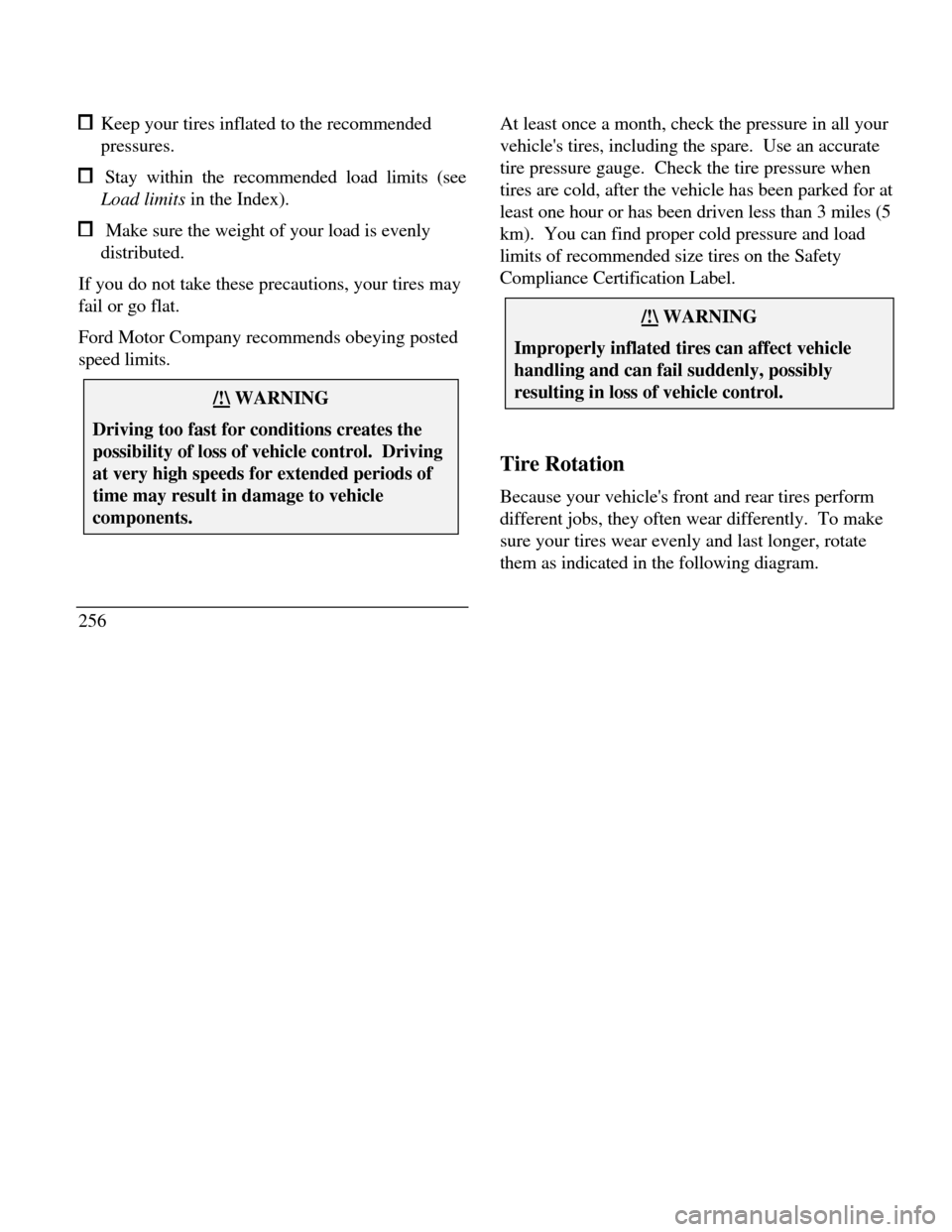Page 258 of 320

Keep your tires inflated to the recommended
pressures. Stay within the recommended load limits (see
Load limits in the Index). Make sure the weight of your load is evenly
distributed.
If you do not take these precautions, your tires may
fail or go flat.
Ford Motor Company recommends obeying posted
speed limits./!\ WARNINGDriving too fast for conditions creates thepossibility of loss of vehicle control. Drivingat very high speeds for extended periods oftime may result in damage to vehiclecomponents.256At least once a month, check the pressure in all your
vehicle's tires, including the spare. Use an accurate
tire pressure gauge. Check the tire pressure when
tires are cold, after the vehicle has been parked for at
least one hour or has been driven less than 3 miles (5
km). You can find proper cold pressure and load
limits of recommended size tires on the Safety
Compliance Certification Label./!\ WARNINGImproperly inflated tires can affect vehiclehandling and can fail suddenly, possiblyresulting in loss of vehicle control.Tire Rotation
Because your vehicle's front and rear tires perform
different jobs, they often wear differently. To make
sure your tires wear evenly and last longer, rotate
them as indicated in the following diagram.
Page 261 of 320

Treadwear
The treadwear grade is a comparative rating based
on the wear rate of the tire when tested under
controlled conditions on a specified government test
course. For example, a tire graded 150 would wear
one and one-half (1 1/2) times as well on the
government course as a tire graded 100. The
relative performance of tires depends upon the
actual conditions of their use, however, and may
depart significantly from the norm due to variations
in driving habits, service practices and differences in
road characteristics and climate.
Traction A B C
The traction grades, from highest to lowest, are A, B,
and C, and they represent the tire's ability to stop on
wet pavement as measured under controlled
conditions on specified government test surfaces of
asphalt and concrete. A tire marked C may have
poor traction performance. Warning: The traction
grade assigned to this tire is based on braking(straightahead) traction tests and does not include
cornering (turning) traction.
Temperature A B C
The temperature grades are A (the highest), B, and
C, representing the tire's resistance to the generation
of heat and its ability to dissipate heat when tested
under controlled conditions on a specified indoor
laboratory test wheel. Sustained high temperature
can cause the material of the tire to degenerate and
reduce tire life, and excessive temperature can lead
to sudden tire failure. The grade C corresponds to a
level of performance which all passenger car tires
must meet under the Federal Motor Vehicle Safety
Standard No. 109. Grades B and A represent higher
levels of performance on the laboratory test wheel
than the minimum required by law. Warning: The
temperature grade for this tire is established for a tire
that is properly inflated and not overloaded.
Excessive speed, underinflation, or excessive
259
Page 262 of 320

loading, either separately or in combination, can
cause heat buildup and possible tire failure.
Snow tires
The tires on your vehicle have all-weather treads
that provide traction in rain or snow. However,
during the winter months in some climates, you may
need to use snow tires.
Use of tire chains is not recommended. The use of
tire chains could result in damage to your vehicle./!\ WARNINGSnow tires must be the same size and gradeas the tires you Currently have on yourvehicle.Cleaning the Wheels
Wash the wheels with the same detergent you use
to wash your vehicle's body. Do not use acid-based
wheel cleaners, steel wool, abrasives, fuel, or strong
260detergents. These substances will damage protective
coatings. Use tar and road oil remover to remove
grease and tar.
NOTE: Before going to a car wash, find out if the
brushes are abrasive.
If you have whitewall tires that are difficult to clean
with regular detergent, use whitewall tire cleaner.
Follow the directions on the container and rinse the
tires with plenty of clean water.
Securitires (If equipped)
Securitires are designed to allow you to continue
driving your Continental a limited number of miles
when one of your vehicle's tires is at low or even
zero air pressure./!\ WARNINGDo not use aerosol tire inflator/sealer withSecuritires. Doing so may damage the tire'spressure sensor.
Page 310 of 320

Engine coolant temperature gauge,.Fluid refill capacities.............................287
description..............................66Ford Dispute Settlement Board............214
Engine fan......................................233Ford Extended Service Plan......................6
Engine oil.......................................Ford Motor Company of Canada..........219
"break-in" oils............................6Ford of Canada Customer...........................
changing oil and oil filter............247Assistance Centre...............................219
checking and adding..................245Foreign registration..............................221
dipstick......................................246French owner guides, how to obtain.........3
disposal232, 250, 262.Fuel............................................................
engine oil pressure warning light54calculating fuel economy..................243
filter, specifications....................288capacity...........................................287
refill capacities...........................28-choosing the right fuel......................240
specifications.............................289comparisons with EPA fuel economy.....
synthetic oil...............................245estimates.......................................243
viscosity....................................245filling your vehicle with fuel.............238
Exhaust fumes................................49filter, specifications..........................288
Extended Service Plan, Ford...........6fuel gauge..........................................67
F....................running out of fuel...........................242
Flashers, hazard..............................92safety information relating to..................
Flashing the lights...........................90automotive fuels............................241
Flat tire..........................................204storing your vehicle..........................291
......................................................treating emergencies........................241
312